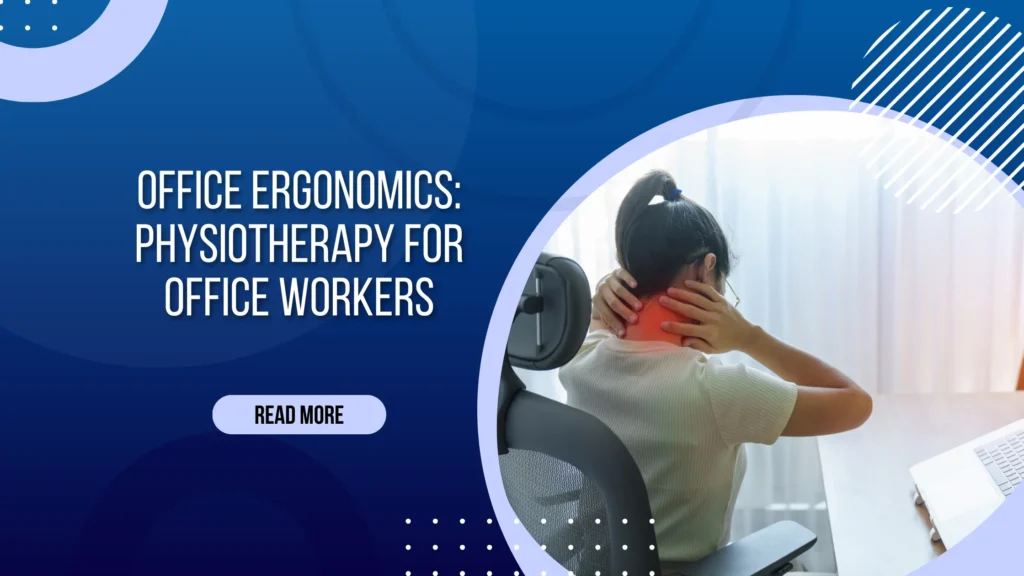Sitting for long hours at a desk has become a daily routine for many office workers. However, this lack of movement, along with poor posture and repetitive tasks, often leads to common health issues like neck and back pain, stiffness, carpal tunnel syndrome, and bad posture. These problems can cause constant discomfort, reduce productivity, and affect overall well-being.

If not treated on time, these issues can become more serious and harder to manage. Many people try temporary fixes like painkillers or quick stretches, but without proper care, the discomfort often returns. That’s where Vishudh Kaya Pain Relief and Multispeciality Clinic comes in.
Our clinic specializes in treating work-related musculoskeletal issues through advanced physiotherapy techniques. Our expert team helps relieve pain, improve posture, and restore movement, ensuring that office workers stay comfortable, healthy, and active.
By addressing the root causes of these conditions, we aim to not only provide relief but also prevent future issues, ensuring long-term well-being. Whether you’re already experiencing pain or want to take preventive steps, our treatments are designed to support a healthier, more comfortable lifestyle.
Common Health Issues Faced by Office Workers
Long hours of sitting, repetitive tasks, and poor workstation setups can lead to several health problems for office workers. These issues not only cause discomfort but can also develop into long-term complications if not properly managed. Some of the most common concerns include:
1. Neck and Shoulder Pain
Spending extended hours at a desk with improper ergonomics can strain the neck and shoulders. Poor screen positioning, lack of movement, and an unsupported posture often lead to stiffness, tension, and persistent pain in these areas.

2. Lower Back Pain
Incorrect sitting posture, minimal physical movement, and inadequate back support put stress on the lower spine. Over time, this can weaken the back muscles and contribute to chronic pain, making it difficult to maintain a comfortable and healthy posture.
3. Carpal Tunnel Syndrome
Constant typing, prolonged mouse use, and repetitive wrist movements can cause excessive strain on the hands and wrists. This may result in carpal tunnel syndrome, a condition where the median nerve in the wrist becomes compressed, leading to pain, tingling, and numbness in the fingers.
4. Poor Posture
Sitting with a slouched back, forward head posture, or rounded shoulders for long periods can negatively affect spinal alignment. Poor posture can lead to muscle imbalances, stiffness, and increased strain on the neck and back, eventually resulting in long-term discomfort.
5. Eye Strain and Headaches
Prolonged screen exposure, poor lighting, and improper monitor placement can cause digital eye strain. Symptoms include dryness, irritation, blurred vision, and frequent headaches, which can reduce concentration and work efficiency.
Recognizing these common workplace health concerns can help individuals take proactive steps to prevent and manage them. In the next section, we will explore physiotherapy-based solutions to alleviate these problems and promote overall well-being.
How Physiotherapy Can Help
Physiotherapy is highly effective in addressing and preventing common musculoskeletal problems faced by office workers. By focusing on posture correction, pain relief, and ergonomic improvements, physiotherapy helps individuals maintain a healthier and more comfortable work life. Here’s how it can make a difference:
1. Posture Correction
Many office workers develop poor posture due to prolonged sitting and improper workstation setup. Physiotherapists use specific techniques to improve spinal alignment, strengthen core muscles, and teach proper sitting and standing postures to reduce strain on the body.
2. Pain Relief
Neck, shoulder, back, and wrist pain can be effectively treated through physiotherapy. Manual therapy, targeted stretching, and strengthening exercises help relieve muscle stiffness, reduce tension, and restore mobility, allowing individuals to work more comfortably.
3. Ergonomic Advice
A poorly arranged workstation can contribute to ongoing pain and discomfort. Physiotherapists provide ergonomic recommendations, such as adjusting desk height, chair support, and monitor positioning, to minimize physical strain and promote better posture.
4. Preventive Care
To reduce the risk of long-term musculoskeletal problems, physiotherapy emphasizes preventive exercises. These include simple mobility routines, muscle-strengthening activities, and flexibility exercises that help protect the body from repetitive strain injuries.
5. Stress Relief
Physiotherapy also plays a role in managing stress and tension. Techniques like guided breathing, relaxation exercises, and soft tissue therapy help reduce physical and mental stress, promoting overall well-being and better concentration at work.
By incorporating physiotherapy into their daily routine, office workers can alleviate discomfort, improve posture, and prevent long-term health issues. In the next section, we will explore simple exercises and lifestyle adjustments that can further support workplace wellness.
Simple Exercises and Stretches for Office Workers
Sitting for extended periods can lead to stiffness, discomfort, and poor posture. These easy stretches and exercises can help reduce tension and promote better mobility:
- Neck Stretches: Gently tilt your head forward, backward, and side to side to release tension in your neck and shoulders. Hold each stretch for 10–15 seconds.
- Upper Back Stretches: Stretch your arms forward and round your upper back to correct slouching and support better posture. Pressing your palms outward can enhance the stretch.
- Wrist and Hand Exercises: Rotate your wrists, stretch your fingers, and perform simple flexion and extension movements to keep your hands flexible and reduce the risk of carpal tunnel syndrome.
- Lower Back Stretches: While seated, twist your torso gently to each side or lean forward slightly to stretch and relieve lower back tightness.
- Seated Mobility Exercises: Try small movements like ankle circles, shoulder rolls, or seated marches to boost circulation and prevent stiffness—all from the comfort of your chair.
Practical Strategies to Stay Active and Energized During the Workday
A sedentary work routine can lead to stiffness, poor posture, and reduced energy levels. Incorporating movement throughout your day can improve circulation, prevent discomfort, and enhance productivity. Here are some effective ways to stay active while working:

- Take Frequent Movement Breaks: Sitting for prolonged periods can cause muscle stiffness and fatigue. Aim to stand up, stretch, or take a brief walk every hour. Setting a reminder or using a timer can help you develop this habit. Even a short walk around your office or home can boost circulation and refresh your mind.
- Alternate Between Sitting and Standing: If possible, use a height-adjustable desk or find ways to stand periodically while working. Standing for even a few minutes every hour can reduce strain on your back, engage your core muscles, and improve posture. If a standing desk isn’t available, try standing during phone calls or meetings.
- Incorporate Gentle Stretching and Mobility Exercises: Simple stretches for the neck, shoulders, wrists, and lower back can help alleviate tension from long hours of sitting. Rolling your shoulders, stretching your arms overhead, or doing seated spinal twists can improve flexibility and prevent stiffness.
- Practice Deep Breathing and Relaxation Techniques: Stress and tension can contribute to physical discomfort. Taking deep breaths, practising mindfulness, or engaging in short meditation sessions can promote relaxation and mental clarity, making it easier to stay focused throughout the day.
- Stay Hydrated and Maintain a Balanced Diet: Proper hydration is crucial for muscle function and overall health. Drinking enough water throughout the day helps prevent muscle cramps and fatigue. Additionally, consuming a well-balanced diet with nutrient-rich foods supports sustained energy levels and keeps your body functioning optimally.
By making these small yet impactful adjustments, you can create a healthier, more active work routine that enhances both physical well-being and productivity.
Why Choose Vishudh Kaya Pain Relief and Multispeciality Clinic?
Sitting for long hours, poor posture, and repetitive work movements can lead to chronic neck, back, and shoulder pain. At Vishudh Kaya Pain Relief and Multispeciality Clinic, we specialize in treating these workplace-related musculoskeletal issues with expert care and innovative techniques.
✅ Focused Treatment for Office-Related Pain
We understand the physical strain of desk jobs and provide targeted physiotherapy to reduce pain, improve posture, and restore mobility for a healthier work life.
✅ Customized Care for Lasting Relief
Our experienced physiotherapists design individualized treatment plans tailored to your unique condition, ensuring effective, long-term results.
✅ Advanced Physiotherapy with a Holistic Approach
We utilize cutting-edge physiotherapy techniques to not only relieve pain but also prevent it from recurring, promoting long-term well-being.
Take the First Step Toward a Pain-Free Workday!
Don’t let discomfort disrupt your daily routine. Book a consultation today and experience expert physiotherapy care at Vishudh Kaya!
Conclusion
A sedentary lifestyle and poor posture can contribute to chronic pain and long-term health problems. Addressing these issues early is key to staying pain-free, productive, and healthy.
At Vishudh Kaya Pain Relief and Multispeciality Clinic, we provide expert physiotherapy to help office workers manage and prevent musculoskeletal discomfort. Our personalized treatments ensure long-lasting relief, helping you maintain an active and comfortable lifestyle.
Put your health first! Don’t wait for pain to take over—book a consultation today and take the first step toward a pain-free life.
FAQs for Office Ergonomics
What is office ergonomics, and why is it important?
Office ergonomics is the science of designing a workspace to fit the worker, reducing strain and preventing injuries. It’s important because poor ergonomics can lead to chronic pain, poor posture, and long-term health issues like back pain, carpal tunnel syndrome, and neck strain.
What are the most common office-related injuries?
The most common injuries include:
Lower back pain (from poor sitting posture)
Neck and shoulder pain (from incorrect monitor height)
Carpal tunnel syndrome (from improper keyboard/mouse use)
Eye strain (from poor lighting or screen glare)
How can physiotherapy help office workers?
Physiotherapy helps office workers by:
Correcting posture and alignment
Relieving muscle tension and pain
Strengthening core muscles to support the spine
Providing exercises to prevent repetitive strain injuries
What are some simple ergonomic tips for office workers?
Chair: Adjust your chair so your feet are flat on the floor and your knees are at a 90-degree angle.
Desk: Keep your desk at elbow height to avoid slouching.
Monitor: Position the top of your screen at eye level, about an arm’s length away.
Keyboard/Mouse: Keep them close to your body to avoid overreaching.
Breaks: Take short breaks every 30 minutes to stretch and move around.
How often should I take breaks at work?
It’s recommended to take a 5-10 minute break every hour to stretch, walk, or perform simple exercises. This helps reduce muscle stiffness and improves circulation.
What are the best stretches for office workers?
Neck Stretch: Tilt your head to one side, holding for 10 seconds. Repeat on the other side.
Shoulder Roll: Roll your shoulders forward and backwards in a circular motion.
Wrist Stretch: Extend your arm, pull your fingers back gently, and hold for 10 seconds.
Seated Spinal Twist: Sit upright, twist your torso to one side, and hold for 10 seconds. Repeat on the other side.
Can poor office ergonomics lead to long-term health issues?
Yes, poor ergonomics can lead to chronic conditions like:
Herniated discs
Chronic back and neck pain
Repetitive strain injuries (RSI)
Tendonitis
How can I set up an ergonomic workstation at home?
Use a chair with lumbar support.
Place your monitor at eye level.
Keep your keyboard and mouse at elbow height.
Use a footrest if your feet don’t touch the ground.
Ensure proper lighting to reduce eye strain.
When should I see a physiotherapist for office-related pain?
You should consult a physiotherapist if:
Pain persists for more than a few days
You experience numbness or tingling in your hands or feet
Your pain interferes with daily activities
You want to prevent future injuries
How can Vishudh Kaya Clinic help with office ergonomics?
At Vishudh Kaya Clinic, we offer:
Personalized ergonomic assessments
Physiotherapy sessions to relieve pain and improve posture
Customized exercise plans for office workers
Expert advice on setting up an ergonomic workspace


